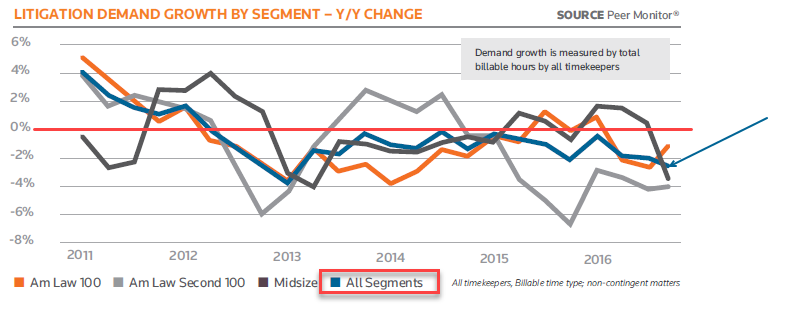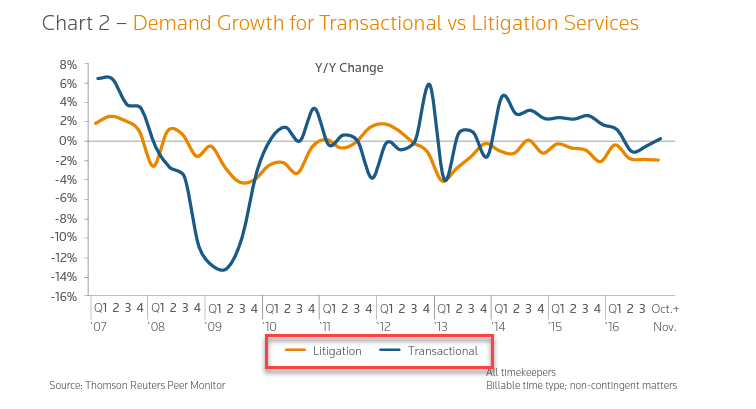The first truly evil character to appear in Scripture is of course the Snake in the Garden of Good and Evil. Not a nice guy, not someone you’d want to emulate, not a role model: The Snake of all Snakes at the coulda-been Eternal Garden Party, harbinger of bad news for humanity.
But hey, why should we let that nasty example stop us?
We’ve been thinking for some time now about a topic that not too many of you out there might want to hear: What if Litigation as a pillar practice area is in long-run secular decline?
Now that I have your attention, let me clarify what I am and am not hypothesizing, because this scenario, if it plays out in any form resembling how we imagine it, will be very dissimilar across law firm sectors. Proceeding roughly in order of good news to bad news:
- The very high-end, “category killer,” elite litigation boutiques–think Bartlit Beck, Cohen & Gresser, Munger Tolles, Williams & Connolly, Zuckerman Spaeder–will be fine. The world’s supply of rich and/or prominent people behaving badly is inexhaustible. (Even the most cursory list ranges from the sublime to the you-know: Eliot Spitzer, Dominique Strauss-Kahn, Jeff Skilling, Elizabeth Holmes, Bernard Madoff, Sam Bankman-Fried, ,….)
- Elsewhere on the prestige spectrum, local, metro-area, and regional champions will be fine. In small and medium-sized cities, commercial activity per se generates litigation: Bankers suing real estate developers and vice versa, competitors alleging IP theft and talent poaching, homeowners suing developers, doctors/architects/engineers/hospitals accused of professional malpractice, and the good old former-business-partners’ rancorous divoce are an everflowing spring of “see you in court!” ultimatums. These clients rightly want the local home-grown lawyer/law firm to represent them, because of their invaluable and irreproducible local knowledge. “Everyone knows” that so and so drinks too much at the country club, that this prominent businessperson is having an affair with that prominent businessperson, which City Council members are malleable and which pillars of integrity, that Hardware Store A stands behind its products forever and ever and that B subscribes to “all sales final/no refunds” no matter what, and so on and so on. There is no substitute for this embedded local knowledge.
- Analogous to the lit boutiques are the elite “Maroon” firms that are litigation powerhouses with almighty scale (think Davis Polk, Kirkland, Latham, Paul Weiss, Quinn). These are quintessentially “safe” choices when the CEO and/or Board of a Fortune 500 is facing a seriously nasty high-profile dispute. (Query how much litigation capacity these firms will continue to need: Apple v. Samsung doesn’t come along every day, plus see our thoughts on Large Language Models and Generative AI a bit further along here.)
- Finally, we have the national, full-service, destination for nothing that immediately comes to mind, firms populating so much of the AmLaw 200. The obstacles they face include:
- Limited/shallow local knowledge;
- Fairly stiff and inflexible rate cards;
- And frankly a reputation, deserved or otherwise, for overstaffing, overcharging, and churning lawyers on matters.
We discovered that as far back as 2016, under the banner of its since-retired “PeerMonitor” brand, Thomson Reuters voiced some analogous thoughts in a piece titled Litigation in 2016: An Examination of the Trends. It opens with this:
By the numbers, it looks like the trend we’ve been witnessing for litigation demand over the past several years has finally caught up with the number of litigation matters filed in the United States District Courts: 2016 year-end results show a noticeable decline from the high-water mark set in 2013. While not a remarkable decline, the numbers clearly show that a downward trend in the number of federal litigation matters over the past four years, from a peak of nearly 235,000 matters in 2013, to just shy of 220,000 matters in 2016.
And concludes rather emphatically [emphasis ours]:
CONCLUSION
There is still litigation work to be had, but it appears to be getting harder to come by. Some firms seem to have figured out the formula to capturing increasing levels of litigation work. But it also remains true that litigation continues to be crunched by clients’ desires to manage costs by utilizing alternative providers where possible, or avoiding litigation altogether. Some industry experts speculate that increases in “bet the company” litigation may help drive a resurgence in litigation demand. However, despite any such potential increase, clients may look to break work down into component parts to save costs where possible, so the true benefit of the increase to law firms remains to be seen. It is also evident that smaller firms continue to absorb the lion’s share of litigation work. Like their large law firm counterparts, smaller law firm segments saw the number of litigation matters contract, though not nearly to the same extent as the larger firms.Clients continue to seek cost-effective solutions for their legal needs, and smaller firms seem to be fitting the bill. While a decreasing number of matters, coupled with declining demand, may seem like a recipe for disaster for litigation-heavy firms, the ultimate question remains “is the firm profitable?” No firm wants to see lawyer productivity or matter volume diminish. But creative and enterprising firms will find ways to make individual matters profitable.
This clarifies things quite efficiently: Note that for “All Segments” of law firms in the PeerMonitor dataset litigation “demand growth” (billable hours) was a negative number for five of the six years displayed:
The declines may look, and are, small, but they’re also cumulative. Scarcely the image of a thriving and robust practice firing on all cylinders.
For an even longer-term chart–covering a full decade from 2007 through 2016–comparing litigation to transactional demand growth head to head, we have this from Thomson Reuters’ 2018 State of the Legal Market.
Looking at this through an impressionistic soft-focus long term “best fit,” I would observe that (a) transactional has been above litigation the entire time except for the obviously anomalous period of the GFC in ’08/’09; (b) and by and large transactional has been at levels >0 and litigation at levels <0.
In the most recent quarterly Law Firm Financial Index (1Q2023), litigation is clearly identified as a “counter-cyclical practice,” growing during downturns and shrinking during normal times. Thankfully, periods of normality far exceed in duration periods of downturns; I will let you draw your own conclusions.
Let’s add a qualitative point to this: Clients hate litigation! (The sane ones, anyway.) It’s a zero sum game with a big cut for the lawyers, it generally focuses on assigning blame for bad things that have already happened in the past, it almost never is a source of “value”” to the client or the parties, and to top it all off you might be asked to write a big check at the end to someone you’ve been fighting with furiously and probably are none too fond of.
I’ll add a second point which may strike you as at odds with what I just wrote but is actually quite complimentary: Much of litigation is discretionary. Do you have to pursue that marginal IP infringement? (They’re a small fish and they’ll fail soon enough.) Is that contract breach worth taking to the mat? (They may be judgment-proof and you were able to mitigate your damages immediately.) Or, even if you want to “make a statement,” send a scorched-earth note but not a summons and complaint. Even if you end up in court, you can wage modest conventional warfare and not all-out air/sea/land combined assault. You get the picture.
Plus, as of late Winter 2023 we now have a powerful new ingredient in the mix: Large Language Models and Generative AI. How will they affect litigation as practiced on the ground?
First, it bears noting that even without/before “LLM/GAI,” more conventional technology tools had taken a bigger bite out of lawyerly activity in litigation than in transactional work. Massive litigation had historically been famous for its fat profit margins through piling up hours and hours and hours of leveraged associate time; much of that has simply disappeared already.
But back to the latest technology sea change. What impact will generative AI have on law firm litigation practices? It would be craven to say “too soon to tell,” even though that might be the most baldly accurate response. We can intelligently speculate and project based on what we already know.
- The demand for junior and mid-level associates performing basic blocking and tackling tasks in e-discovery and other preparation will go down even another notch–past the blows it took with predictive search, massive automated document review, etc. Perhaps almost to zero even now, and surely on an asymptotic path to zero going forward.
- About the only task left those junior lawyers was summarizing and condensing the results of the automated search/review noted above, and now that “LLM/GAI” can write perfectly serviceable English given a limited and highly proscribed subject matter, little to no human intervention is needed.*
- Soon enough, the same tools will be able to put together witness binders, propound interrogatories, and much more.
*In all of the discussion of LLM/GAI, keep in mind your editor’s stipulation that this is a very rapidly moving target. We have already seen the shift from ChatGPT 3.5 to 4.0 has been quite astonishing. Wait for 8.0, 12.0, and nn.0
And, since you’re reading Adam Smith, Esq. and not a textbook on neural networks theory, our next question is: What does all this do to the litigation department billing and revenue model? The answer has to be, among other things, that the billable hour, indestructible as it has proven for decades, may finally have met its match. You may have to face the intellectual and moral challenge of billing for results and value. (Years ago the Managing Partner of a high-end drug/device boutique was in high dudgeon that his crack FDA expert could answer a client’s question “in ten minutes! Ten minutes! How on earth am I supposed to bill for that?!”) Not by the hour, my good chap.
A final thought:
What if a core competence of the brave new somewhat-commoditized litigation specialty practice of the future becomes designing and implementing a variety of built-for-purpose value billing templates and calculators? We sometimes call pricing The Dark Art. It is certainly one of those arts, though there are many.
Does this mean finely honed judgment (combined with rationality and sound emotional intuition) of your senior-most litigators will be valued less? To the contrary, their contribution will be of the highest (humanly generated) value. For that you should charge what the market will bear.
But the phalanxes of juniors and mid-levels rising up through the ranks to become those grey-haired consiglieres? The condemnatory term might be along the lines of “excess capacity;” at least while LLM/GAI is on the job.
I said my final thought was that, but I lied.
My final final thought is a question to which as yet I have no snappy comeback. It is therefore a research project here at Adam Smith, Esq.: That question is, “Where do the grey hairs’ come from if the years of training to get there cease to exist as an economically viable activity?”
The firm that answers that first and most convincingly will not see its litigation practice threatened by decline: It will need to build a bigger church, fast.

Photo by Andrea De Santis on Unsplash





The stats you reference do not take into account private arbitration which is growing exponentially at least in my market. Any analysis of litigation clearly has to look at that
Thanks for your input.
This is a question of data hygiene/integrity, and I double-checked with the Thomson Reuters insider (this is TR data, as you know) who knows their data protocols intimately. He said, not at all surprisingly, that they have no choice but to rely on how the firms supplying the raw information categorize things.
Now to the important part: TR does not code for matter or matter type at all (which would presumably be able to distinguish private arbitration from litigation in general), but instead codes for the groups that lawyers submitting the time cards are assigned to. It’s hard for me to believe that lawyers working on private arbitrations would be assigned to any group other than “litigation.”
In other words, I believe private arbitration matters are indeed captured in the total for “litigation.”
Hope this helps, and thanks again for the input.
Your questions are always interesting. Today you pose two provoking questions, to which the answers are perhaps related and maybe even interdependent. Your first question is what leveraged firms will do when they can no longer swell their partner profits through legions of overworked and overbilled associates, because the firms won’t have the litigation gruntwork that had been keeping those associates busy. Your second question is how those firms will generate their supply of litigation greyhairs 25 years from now if they don’t train those same legions.
The AmLaw100 firms, and maybe most of the second 100 as well, expect most of their associates to fail – that is, they expect that most of their associates will not become partners in the firm. They are not trying to train the associates; they are hiring a cohort to act out The Hunger Games but in better clothing and without the risk of actual death on the field of combat. If the gruntwork continues to move toward alternative providers, or India, or AI then they will eventually get the message and hire fewer associates. Conversely, the share of associates who become partners will increase. The firms will still train the same number of greyhairs to work at the firm. They will train fewer “brownhairs” (?) who leave for other positions.